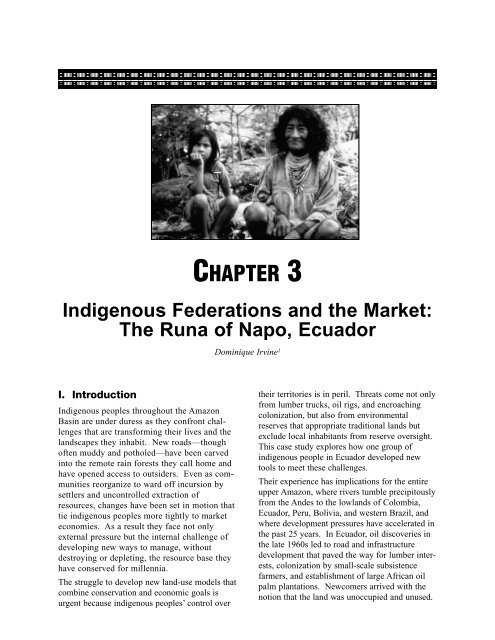Indigenous Peoples and Conservation Organizations
Indigenous Peoples and Conservation Organizations
Indigenous Peoples and Conservation Organizations
You also want an ePaper? Increase the reach of your titles
YUMPU automatically turns print PDFs into web optimized ePapers that Google loves.
CHAPTER 3<br />
<strong>Indigenous</strong> Federations <strong>and</strong> the Market:<br />
The Runa of Napo, Ecuador<br />
Dominique Irvine 1<br />
I. Introduction<br />
<strong>Indigenous</strong> peoples throughout the Amazon<br />
Basin are under duress as they confront challenges<br />
that are transforming their lives <strong>and</strong> the<br />
l<strong>and</strong>scapes they inhabit. New roads—though<br />
often muddy <strong>and</strong> potholed—have been carved<br />
into the remote rain forests they call home <strong>and</strong><br />
have opened access to outsiders. Even as communities<br />
reorganize to ward off incursion by<br />
settlers <strong>and</strong> uncontrolled extraction of<br />
resources, changes have been set in motion that<br />
tie indigenous peoples more tightly to market<br />
economies. As a result they face not only<br />
external pressure but the internal challenge of<br />
developing new ways to manage, without<br />
destroying or depleting, the resource base they<br />
have conserved for millennia.<br />
The struggle to develop new l<strong>and</strong>-use models that<br />
combine conservation <strong>and</strong> economic goals is<br />
urgent because indigenous peoples’ control over<br />
their territories is in peril. Threats come not only<br />
from lumber trucks, oil rigs, <strong>and</strong> encroaching<br />
colonization, but also from environmental<br />
reserves that appropriate traditional l<strong>and</strong>s but<br />
exclude local inhabitants from reserve oversight.<br />
This case study explores how one group of<br />
indigenous people in Ecuador developed new<br />
tools to meet these challenges.<br />
Their experience has implications for the entire<br />
upper Amazon, where rivers tumble precipitously<br />
from the Andes to the lowl<strong>and</strong>s of Colombia,<br />
Ecuador, Peru, Bolivia, <strong>and</strong> western Brazil, <strong>and</strong><br />
where development pressures have accelerated in<br />
the past 25 years. In Ecuador, oil discoveries in<br />
the late 1960s led to road <strong>and</strong> infrastructure<br />
development that paved the way for lumber interests,<br />
colonization by small-scale subsistence<br />
farmers, <strong>and</strong> establishment of large African oil<br />
palm plantations. Newcomers arrived with the<br />
notion that the l<strong>and</strong> was unoccupied <strong>and</strong> unused.

















